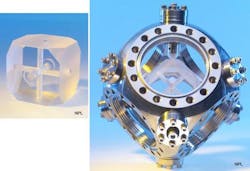Optical stabilizing reference cavity keeps optical-clock laser frequency from drifting off
The National Physical Laboratory (NPL; Teddington, England) has created a precision optical stabilizing reference cavity to enable an optical-clock laser to maintain a drift-free frequency. While the concept of a stable optical reference cavity made of low-expansion material is not new, the NPL device is an especially elegant version.
As European Space Agency (ESA) physicist Eamonn Murphy notes, the 5 cm distance between the cavity's two superpolished mirrors is kept constant due to the ultra-low expansion glass used for the cavity's structural material. The cavity is frequency-locked to the laser.
Such lasers will serve at the heart of next-generation optical atomic clocks, which will improve on current microwave atomic clocks used for timing and navigation. These clocks will also enable ultrasensitive gravity detectors (gravity detectors measure minute variations in the Earth's static gravitational field, in contrast to gravitational-wave detectors like LIGO, which measure gravitational waves traveling at the speed of light).
The working version of the cavity is enclosed in a vacuum chamber to prevent any disturbance by air molecules, followed by a thermal shroud to maintain its temperature to within a small fraction of a degree. It can then be placed on an acoustic damping baseplate to further isolate it from any microvibrations.
This effort began back in 2009 with three parallel projects within ESA's Basic Technology Research Programme, working with the national measuring institutes of France and Germany as well as the UK.
Expertise and elements from all the resulting designs will soon be incorporated into a new working prototype, supported through ESA's General Support Technology Programme, which finalizes hardware for space.
"Our aim is to deliver a six order-of-magnitude improvement in laser linewidth from initial laser performance," says Murphy.
The NPL, which is the UK's national measurement and standards institute, designs and creates precision devices and systems, both optical and nonoptical. For more info on the NPL, see http://www.npl.co.uk.
Source: http://www.esa.int/spaceinimages/Images/2016/11/Optical_stabilising_reference_cavity

John Wallace | Senior Technical Editor (1998-2022)
John Wallace was with Laser Focus World for nearly 25 years, retiring in late June 2022. He obtained a bachelor's degree in mechanical engineering and physics at Rutgers University and a master's in optical engineering at the University of Rochester. Before becoming an editor, John worked as an engineer at RCA, Exxon, Eastman Kodak, and GCA Corporation.
